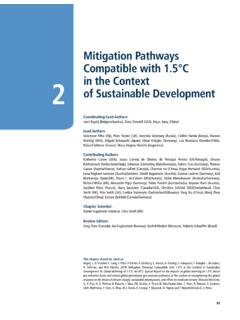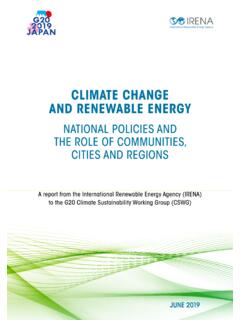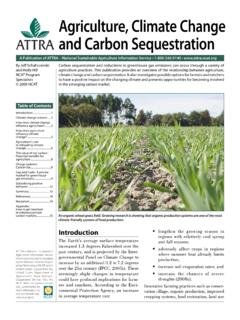Transcription of Climate Variability and Climate Change, What is the ...
1 Climate Variability and Climate ChangeWhat is the difference? The summer of 2009 was one of Michigan s coldest summers on record. In June of the same year, the Global change Research Program published a report stating: Observations show that warming of the Climate is unequivocal. How can scientists say Climate is changing if a sweatshirt is needed to stay warm on a July afternoon?The key to making sense of what seems like contradictory evidence is to understand that just as the weather varies naturally, so too does Climate . Even though scientists have no doubt that Climate is warming, natural Climate Variability will always occur.
2 We cannot draw conclu-sions about Climate change based on one summer. There will be ups and downs even if we are in the middle of a warming trend. Case in point: while summer 2009 was near-record cold, the summer of 2010 was one of the hottest on record. Understanding the difference between Climate Variability and Climate change and how scientists study both allows us to interpret infor-mation on weather and Climate and to make sense of our environment. Climate Variability Climate varies over seasons and years instead of day-to-day like weather. Some summers are colder than others.
3 Some years have more overall precipitation. Even though people are fairly perceptive of Climate Variability , it is not as noticeable as weather Variability because it happens over seasons and years. Evidence includes state-ments like: the last few winters have seemed so short, or there seem to be more heavy downpours in recent years. Scientists think of Climate Variability as the way Climate fluctuates yearly above or below a long-term average value. You can think of it as a story with two parts: average and range. These parts complement each other; understanding the range gives context to the average and vice versa.
4 Average What s typical Climate isn t defined by any particular timeframe, however scientists typically use average weather conditions over 30-year time intervals to track Climate . These 30-year averages are called climatological normals, and are used to determine, monitor or represent the Climate or a specific slice of Climate at a particular location. Thirty years of data is long enough to calculate an average that is not influenced by year-to-year can be calculated for a variety of weather variables, such as MiChigan Sea granttemperature or precipitation based on data from weather stations in the region of interest.
5 There is significant year-to-year Variability around these 30-year averages. For example, in Figure 2 the normal daily maximum temperature for February 15 in South Haven, Michigan is F from 1961-1990. But for each year in that range, the daily maximum temperature is not exactly F ( , in 1967 it was 50 F, in 1979 it was 20 F). This year-to-year fluctuation around the normal is Climate Variability . Key termsn Climate Variability The way Climate fluctuates yearly above or below a long-term average Climate change Long-term continuous change (increase or decrease) to average weather conditions or the range of Climatological normal 30-year average of a weather the Variety Averages only tell half the story of Climate Variability .
6 The variety around the average the range of weather is the other half. When an average is calculated, the variety of the data within is smoothed. But there is much to gain from understanding this variety, especially the extremes. For example, the average air temperature in Marquette, Michigan was F in 2010. But within that year, Marquette residents had to deal with a high of 90 F degrees and a low of -8 F. If you were moving to Marquette and packed only clothes suited for the average temperature, you d be shivering in January and overheating in August. Studying the frequency and magnitude of extremes such as heavy downpours, cold snaps and heat waves is important because these events affect communities the most.
7 Why study Variability ?We use these averages and ranges to make important societal decisions. For example, climatologal normals of precipitation and historical records of storm events are used to calculate probabilities of future rain events. Engineers can then use these data to design community stormwater drainage systems. These data also serve as a baseline against which to compare current weather and Climate data. Without a baseline we have no way to understand how current observations fit into the bigger picture. drivers of Climate Variability include El Ni o and La Ni a events, which are shifts of warm, tropical Pacific Ocean currents that can dramatically affect Michigan s winters.
8 El Ni os give us milder, less snowy winters (such as the winter of 2009-2010), while La Ni as give us colder, snowier winters (such as the winter of 2007-2008). Other drivers of Climate Variability include volcanic eruptions and sunspots. Sometimes Climate varies in ways that are random or not fully explainable. What causes Climate Variability ?continued on Sea Grant enhances the sustainability of Michigan s coastal communities, residents, and businesses through research, outreach and example, let s say you received a B on your latest report card. How do you know if this B is a sign of improvement or if your performance is getting worse?
9 It depends how you did on previous report cards. Without a baseline, it s impossible to changeIf Climate Variability is year-to-year variation, what is Climate change ? Climate change is a long-term continuous change (increase or decrease) to average weather conditions ( average temperature) OR the range of weather ( more frequent and severe extreme storms). Both can also happen simultaneously. Long-term means at least many decades. Climate change is slow and gradual, and unlike year-to-year Variability , is very difficult to perceive without scientific records. How do scientists detect Climate change ?
10 They look for long-term continuous changes (trends) in climatological averages and normals and the variety around these averages. Climate in the Great Lakes region is generally highly variable in the short term, which makes it difficult to tease apart natural Variability from long-term change . However, looking at data since the late 1800s reveals some significant shifts in temperature, total precipitation, and extreme events in recent decades in the Great Lakes region. Scientists use this evidence to conclude that Climate is indeed changing. Climate change occurs because of changes to Earth s environment, like changes in its orbit around the sun or human modification of the atmosphere.







